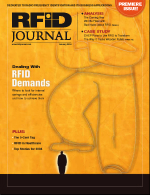This week, many readers will find the first issue of RFID Journal‘s quarterly magazine in their mailboxes. It’s a unique magazine in a couple of ways. Although it’s a technology publication aimed specifically at those looking to deploy RFID, our approach is to deliver the same high-quality editorial and design found in top
consumer business magazines. And while the magazine is focused on a single technology, it doesn’t hype that technology. RFID is so important it doesn’t need hyping.
The articles in the magazine contain real-world examples of how RFID is benefiting companies today. The aim is to show you how your company might benefit as it rolls out the technology. I feel it’s important to provide practical information, because there’s been way too much written about the vague notion of an “RFID Revolution,” with little detail about what the world might look like after the ramparts have been overrun.
Last week, I tried to bring the discussion about RFID back to earth by showing why it helps to think of RFID as a tool. This may be a mundane way of thinking about RFID technology, but talk of revolution makes me uncomfortable. The word conveys dramatic change. And RFID will bring that. But the word also implies replacing what came before with something new. RFID will not replace anything that came before it, including bar codes. RFID builds on what came before it. Without the Internet, companies wouldn’t have the means to share data. And without the huge investments in enterprise resource planning software and enterprise applications, they wouldn’t be able to manage the data and turn it into information that can be acted upon.
I believe RFID is the next major stage in the evolution of information technology. Each stage in the past has brought disruption and change. Evolution isn’t necessarily a neat and orderly process (particularly when it comes to IT). Some companies adapt quickly and thrive, and some don’t adapt and lose ground or even disappear. But evolution takes time, so there’s no need to spend millions to try to change all your processes and systems at once. From the beginning, RFID Journal has advocated a slow, steady approach. Test, deploy, learn, expand. Test, deploy, learn, expand. It’s important to get benefits from each RFID project.
Our cover package in the print magazine, “Mandate for Change” and “Where the Benefits Are,” explain how suppliers can deal with RFID demands. It shows where all companies can look for potential internal savings and how they can achieve them. Taken separately, none of the applications we point to will fundamentally change your business. But if you start with the one area where you expect the greatest return, you can move steadily to deploy RFID across your operations. Over the next three to five years, you’ll be able to expand the use of RFID from one end of your operations to the other. If you do that successfully, each project will provide a return on investment and in the end, you’ll be able to run your company in an entirely new and dramatically more efficient way.
The vision is compelling, and the benefits achieved along the way will grow as RFID becomes cheaper and penetrates deeper into the enterprise. During the next two years, overcoming the obstacles—employee resistance to change, integration costs, system complexity, the vagaries of radio waves and so on—will be a challenge. But the chances of success will be much higher if you take an evolutionary, rather than revolutionary, approach.


